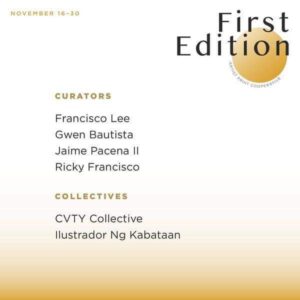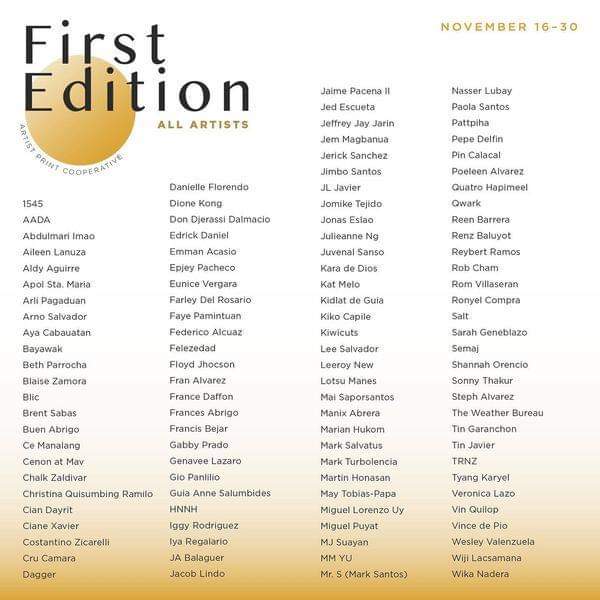Wanting Something More
Cartellino began in late 2018 when Tanya Mallillin, now Cartellino’s creative director, first pitched the idea of an online art digest and shop to Abby Frias Teotico, director of Galerie Stephanie.
Having worked at MEGA Magazine as a graphic designer for a time, the Information Design graduate of Ateneo de Manila University was looking to “apply herself in the local industry of contemporary art.”
Abby Teotico loved the idea. A lover of local contemporary art herself, Abby “wanted something more for it,” and so offered herself as a strategic advisor and investor to see Cartellino through.
With the help of MEGA writer Francesca Testa, the three managed to get the online digest up by September 2019, while the shop held a soft launch last February 2020.
After the first batch of articles, Francesca opted to be a future contributor to the digest instead. The post was then occupied by Elo Dinglasan, who was put on top of content right as Art Fair Philippines 2020 was going to launch.
And then the pandemic. While the idea of an online-only art shop and digest may have been considered novel at first, the team explains, “art galleries, spaces, and independent publishers had to bolster their online presence to sustain operations.”
Inspiration Came from Everywhere
For a start-up to go online at this time offered exciting terrain, however: a lush and robust lot of models for Cartellino to study and draw from. For initial shop templates and visuals, Tanya was inspired by TAPPAN and Vice’s i-D, “but the overall idea of an art e-commerce site came from Artsy.”
As for the digest, the editorial looked into the industry heavyweights: ArtReview, art-agenda, Flash Art, and Artforum, among others, to reconsider directions for the digest content.
Closer to home was Singapore’s Plural Art Mag, and even closer were contributors to CNN PH Life, Manila Art Blogger, Jed Gregorio’s “Artist Talks” for the Philippine Inquirer, the UP Vargas Museum’s Philippine Contemporary Art Network or PCAN, Ateneo’s Kritika Kultura, and Carlos Quijon Jr.’s tractions: experiments in art writing.
Inspiration came from everywhere and everything available. While none of the influences may have translated directly to how Cartellino does things, it left a distinct impression: “Bottom line,” the team explained, “We looked at people who started something and succeeded, mainly by inventing their own way.”
Fostering Further Appreciation
Unlike similar platforms, Cartellino openly acknowledges its limits as a company of two. “There’s a lot of ground to cover; we can’t do it all alone. The best that we can do is be attentive, be ‘embedded’ in what’s happening so that whatever we can cover, it comes from an informed perspective.”
They believe this informed perspective can help jostle more people to experience the local goings-on for themselves, generate creative responses, or ask more questions.
“It’s just about fostering further appreciation: letting people withhold judgment for a minute and see the art (and its industry) for themselves,” Elo explained. “Knowing what goes into how one looks and why is another thing altogether. We see our readers as people who want to tag along with us as we figure that out, as people looking to get in on the conversation.”
To be embedded, Cartellino has a simple three-step process: “Look at art, Look at more art, and talk conscientiously about art (as [they] look at it).”

Launching “First Edition: Artists Print Cooperative”
Curator Ricky Francisco liked how the team named Cartellino’s flagship project “First Edition: Artist Print Cooperative,” being its inaugural project. Meanwhile, the word “cooperative” centered on the idea of “artists supporting artists and people in need.”
For the past couple of months, Cartellino has enlisted the help of individual artists, photographers, curators, and art collectives to participate in First Edition. In partnership with Print Now, First Edition is a two-week run of limited edition archival prints, dedicated to overall artist support and multiple beneficiaries.
“How this works is that participating artists send high-resolution images of up to three of their artworks, along with the necessary artwork details, and we offer them a transparent price model for them to know—from a purchase—how much of the proceeds go to them, to the beneficiaries, and to the artist communal fund.”
After necessary deductions (production costs and transaction fees, etc.), the profit allocation follows a 50/30/20 model. From a purchase, 50% goes to the artist, 30% goes to the beneficiary, and 20% goes to the communal artist fund to be split afterward evenly among the artist participants.
From there, artists are free to set the edition number and the selling price. As all rights remain with the artists, they are free to sell unsold limited editions after the event, with Cartellino out of the picture.
“Cartellino’s service charge is priced in a way to break even—we’re not looking to earn from this. This is us giving back,” Tanya shares.
Banking on the Accessibility of Prints
Since prints set a lower price floor that caters to and encourages beginners to art collecting, Cartellino believes that “the accessibility accorded to prints and reproductions would (hopefully) lead to more substantial proceeds all around.”
On top of that, prints are more portable. “If you’re a student in a dorm or someone jumping from one apartment to another, prints might be a better option than lugging your parents’ prized Manansala,” Elo quips.
Prints make art more accessible. While the lowered price points will certainly help more people purchase art they like, Cartellino made sure the prices won’t shortchange the artists behind the works either. “They’re all appropriately priced. It was important for us to make sure everyone involved knew how much goes into where, based on the prices they chose.”
The project follows a Print on Demand model. This keeps the endeavor generally hassle-free on the artists’ part: “All we will need from them during the event is to sign the works we’ve printed before shipping them out.”
Although Cartellino is determined to help people—artists, collectors, and beneficiaries alike—they know the underlying risk of First Edition.
The success of the project hinges on an untapped market: “We’re waging a bet that there are indeed broader and more diverse audiences out there looking for ways into contemporary art, this project is just one of those ways.”
Envisioning Cartellino’s Future
In equal priority, the Cartellino team hopes to “make Cartellino a sustainable business, one that can support as many artists as possible, and ensure that those consigned in [their] shop reach appreciative audiences. For the digest, Cartellino hopes to be a reliable informant for local contemporary art.”
In three years, the team shares, “We hope Cartellino could by then hire more, have a more expansive digest and shop portfolio, and be able to commit to local collaborations on the regular.”
For more information, email cartellino.art@gmail.com or editions.cartellino@gmail.com. You may also visit their website cartellino.com, Instagram @cartellino.art, or Facebook /cartellino.art.




